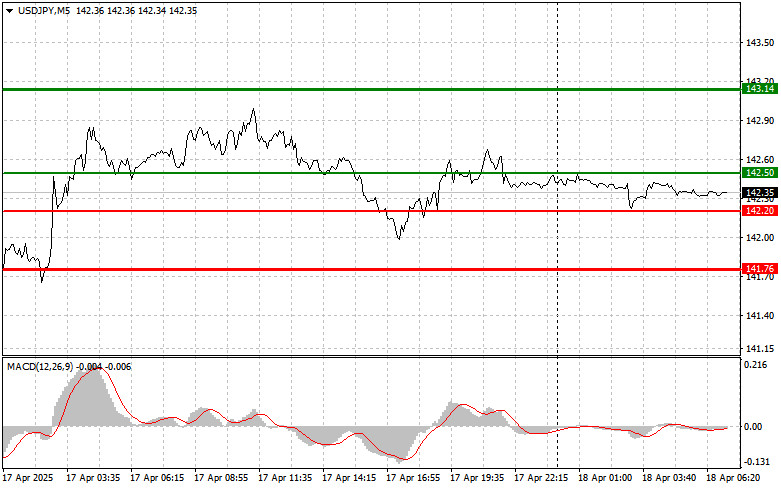Analysis of Trades and Trading Tips for the Japanese Yen
The test of the 142.38 level coincided with a moment when the MACD indicator had already significantly moved below the zero mark, which limited the pair's downside potential. For this reason, I did not sell the dollar. I did not receive any other entry signals into the market.
Surprisingly, despite new headlines about trade negotiations between the U.S. and Japan, the market seemed to freeze in anticipation. Not even Japan's inflation data influenced volatility. According to the report, Japan's Consumer Price Index (CPI) decreased to 3.6% from 3.7% in March this year. However, the CPI excluding fresh food prices rose to 3.2% from 3.0% recorded in February.
This mixed dynamic raises particular concerns, reflecting uneven inflationary processes in the country. A decrease in the general CPI may indicate weakening consumer demand or the effectiveness of inflation-curbing measures. However, an increase in the core CPI (excluding fresh food) signals persistent inflationary pressure in other sectors of the economy, which may offset the positive impact of the general index decline. The implications of this situation for the Bank of Japan's monetary policy remain uncertain. On one hand, the drop in the general CPI might push the central bank toward a wait-and-see approach. On the other hand, the steady rise in the core CPI could prompt the BOJ to continue raising interest rates—something many traders are betting on as they sell off U.S. dollars and buy Japanese yen.
For intraday strategy, I will focus primarily on implementing Scenarios #1 and #2.
Buy Signal
Scenario #1: I plan to buy USD/JPY today upon reaching the entry point around 142.50 (green line on the chart), with a target of 143.14 (thicker green line). At the 143.14 level, I plan to exit long positions and open short positions in the opposite direction (anticipating a 30–35 pip reversal). It's best to return to buying the pair during corrections and substantial pullbacks in USD/JPY.
Important: Before buying, ensure the MACD indicator is above the zero line and beginning to rise.
Scenario #2: I also plan to buy USD/JPY today in case of two consecutive tests of the 142.20 price level while the MACD indicator is in the oversold area. This will limit the downside potential and lead to an upward market reversal. A rise to the opposite levels of 142.50 and 143.14 can be expected.
Sell Signal
Scenario #1: I plan to sell USD/JPY today only after a breakout below the 142.20 level (red line on the chart), which would result in a sharp drop in the pair. The key target for sellers will be the 141.76 level, where I plan to exit short positions and immediately open long positions in the opposite direction (anticipating a 20–25 pip rebound). Selling pressure may return at any moment.
Important: Before selling, ensure the MACD indicator is below the zero line and starting to decline from it.
Scenario #2: I also plan to sell USD/JPY today if there are two consecutive tests of the 142.50 level while the MACD indicator is in the overbought zone. This will limit the pair's upside potential and lead to a market reversal downward. A decline to the opposite levels of 142.20 and 141.76 can be expected.
What's on the Chart:
- The thin green line represents the entry price where the trading instrument can be bought.
- The thick green line indicates the expected price level where a Take Profit order can be placed, or profits can be manually secured, as further price growth above this level is unlikely.
- The thin red line represents the entry price where the trading instrument can be sold.
- The thick red line indicates the expected price level where a Take Profit order can be placed, or profits can be manually secured, as further price decline below this level is unlikely.
- The MACD indicator should be used to assess overbought and oversold zones when entering the market.
Important Notes:
- Beginner Forex traders should exercise extreme caution when making market entry decisions. It is advisable to stay out of the market before the release of important fundamental reports to avoid exposure to sharp price fluctuations. If you choose to trade during news releases, always use stop-loss orders to minimize potential losses. Trading without stop-loss orders can quickly wipe out your entire deposit, especially if you neglect money management principles and trade with high volumes.
- Remember, successful trading requires a well-defined trading plan, similar to the one outlined above. Making impulsive trading decisions based on the current market situation is a losing strategy for intraday traders.













